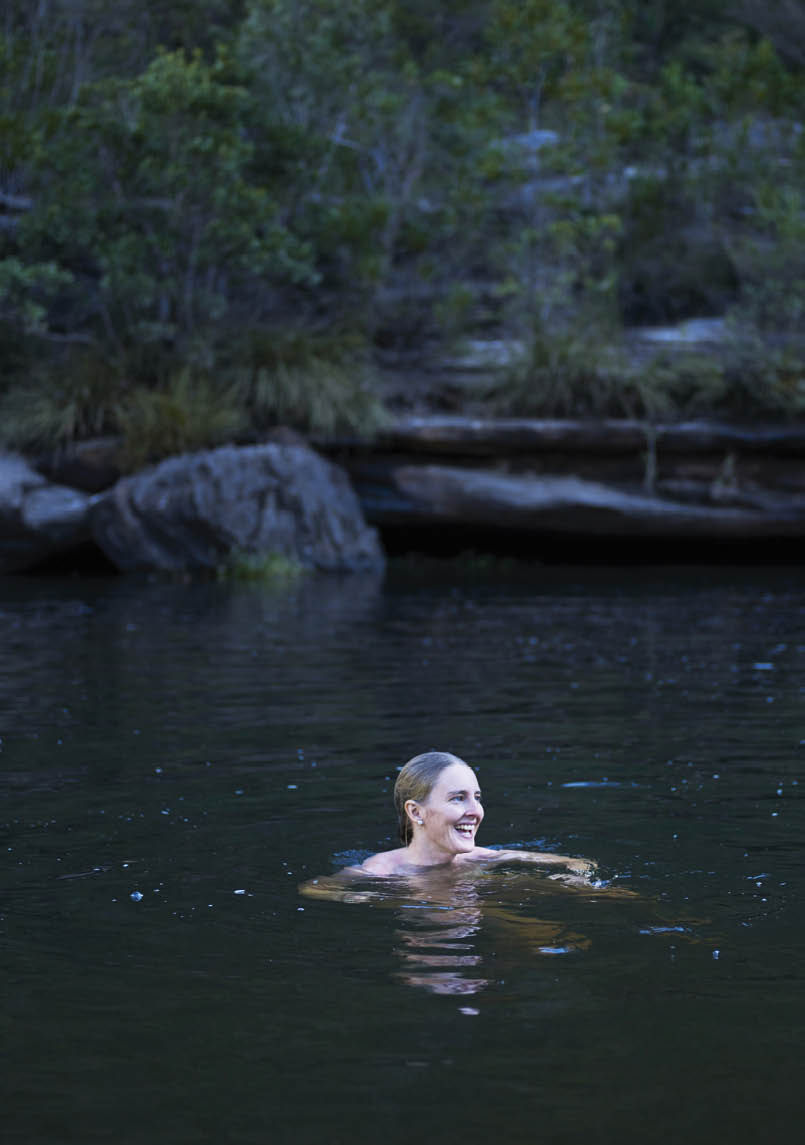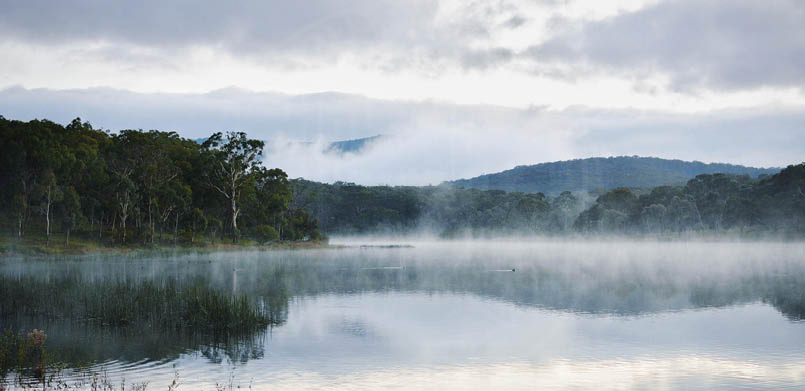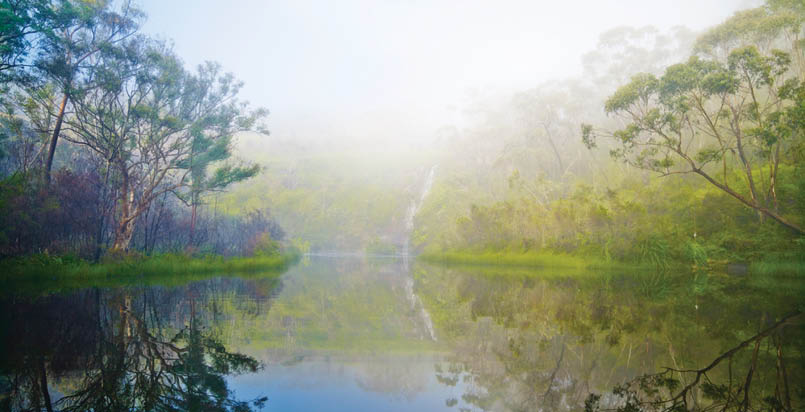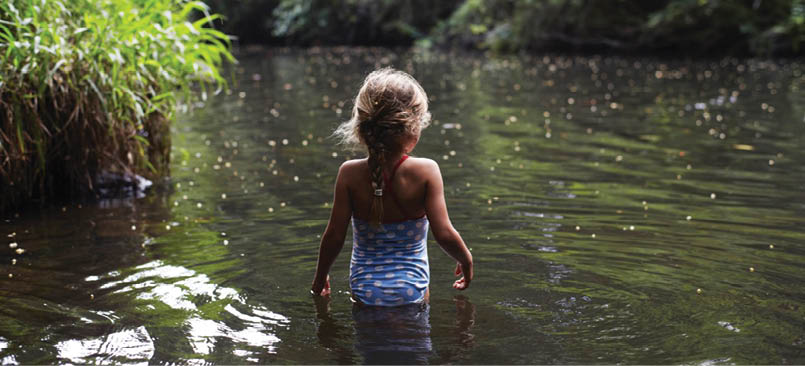

Glenbrook CreekAndy Lewis/Wild Swimming Australia
“Aaaaaaarghhhh, it's freeeezing!', I gasp as the sound of my squeals reverberates around the rocky amphitheatre below Minnehaha Falls in the Blue Mountains.

Winter swimming
Rachel Lewis

54 | BWA August 2016




“It's refreshing Mummy”, my seven-year-old daughter reminds me, telling me what I've told her a hundred times. Nevertheless, she dips her feet in and then decides to retreat to her towel and enjoy the view as my husband and I continue swimming across the small but very deep pool below the impressive falls. We then climb out onto the rocks to get dressed and bask in the winter sun, which filters through the trees and gradually returns some life to our extremities. Only the brisk walk back up the trail to the car park will finish the job, but by then the euphoria will have kicked in and we'll be talking about how awesome it was, completely forgetting the shock and the fleeting thoughts of, “I'm never doing this again”. I guess it's a bit like childbirth: painful at the time but the rewards come later.
I'm not entirely sure exactly what happens biologically when the body is exposed to cold water but I know that, for me at least, it feels amazing. It's probably something to do with feel-good hormones which are produced when our bodies experience stress. Cold showers have even been shown to effectively treat depression. There are biological changes that happen with long-term, repeated exposure to cold water, such as improved circulation, less respiratory infections, increased antioxidant levels and the restorative effects of being in nature. These changes mean that wild winter swimming could be seriously good for your sense of wellbeing.
Ross MacDowell from the Brighton Icebergers swimming club in Melbourne sums up what many cold-water swimmers know to be true.
“When you get out after swimming in nine degree water and you can't feel anything, you can't feel your hands and feet, your teeth are chattering, you can't even see straight, it doesn't matter because you feel like you've been re-born. No matter what's going on in your life, whether you're a politician or a retired plumber - we all have struggles – but cold-water swimming is like a feather duster on a chalk board: it rubs it all out. You get out of the water and you're alive, you survived!”
But the reasons people swim in cold water don't stop there. There's something about the winter landscapes that many swimmers, including me, find more beautiful. Maybe its the lower light, creating stark silhouettes of the trees, the peace and quiet, or the fact that waterfalls are likely to be in full flow. Hardened winter swimmer Peter Hancock loves it all.
“I swim in all seasons, but I think I prefer winter to the others. One reason is that the water is clearer at low temperatures because there is less life (algae, phytoplankton and zooplankton), and the water has a lower capacity for absorbing organic matter.
“Above the water, the landscape is more beautiful than in summer. The water has a darker, more moody feel to it, the grass is
Mist at Dumaresq DamPeter Hancock/Wild Swimming Australia
BWA August 2016 | 55


frosted white, and there is often mist swirling up off the water. I also enjoy the solitude. Where I swim most often is Dumaresq Dam. During winter, when the water is six degrees and the air is below zero, there is nobody there. I feel as though I have my own private lake to share with the musk ducks, coots, and wood ducks. However, with all of the reasons above, perhaps the main reason I swim during winter where I do is because nobody else does. It makes the whole experience mine.”
And Peter will go to great lengths to get his winter swim fix, even being known to swim in the snow on occasion.
Pretty much all the swimming holes on the Wild Swimming Australia map will have their own charm in winter and are pretty much guaranteed to be uncrowded. However, it's a great time to seek out more sheltered spots such as the tranquil Ingar Pool in the Blue Mountains, where you can exit the water and head straight back to your campfire in the campsite just metres from the pool.
Whilst waterfalls such as Minnehaha Falls are really impressive to look at after heavy rain, it's not always a great time for a dip at the bottom: huge amounts of water will be moving through causing powerful, unpredictable currents. Whilst breathtaking, waterfall pools are best left for days when there hasn't been recent rain and the water will be calmer, cleaner and clearer.
Swimming spots on lakes such as Acacia Flat and Beehive Point on Lake Yarrunga, NSW are another great option for winter wild swimming as currents will not be much of an issue and the water is likely to be crystal clear in colder temperatures. These too have the added luxury of a fire pit for warming up post-swim, as well as being close to the famous pie shop in Kangaroo Valley; a great place to warm the insides.
Even the more urban spots which are very popular in summer, such as Manly Dam or Lake Parammatta in Sydney, are likely to be empty of swimmers in the colder months while beaches such as the stunning Elephant Cove in Western Australia, with it's unique bouldery scenery, are likely to be completely deserted.
No matter how crazy it may seem to the uninitiated, there are plenty of winter swimming enthusiasts out there, as proved by the existence of the Winter Swimming Association of Australia and the slightly less official sounding “Hobart Nude Winter Solstice Swim”. And there is safety, or at least motivation, in numbers. Ross MacDowell says that the camaraderie of his fellow Icebergers is what he enjoys most about swimming in the winter. It certainly takes a “special” (read “slightly deranged”) mentality to hurl yourself into freezing water daily. But if that's what floats your boat then it's a bonus to find a tribe of like-minded souls.
Ingar PoolAndy Lewis/Wild Swimming Australia
56 | BWA August 2016

If you can get past the bellybutton, it's plain swimming from thereAndy Lewis/Wild Swimming Australia
It's worth bearing in mind that winter storms bring their own set of risks such as significantly faster currents in rivers and the ocean, and potentially large obstacles such as branches which can be washed down with extra rain. This means that there will be days when some normally safe and popular spots are unsuitable for swimming. It also helps to learn about the risks of cold water and how to acclimatise your body to the cold to minimise these
If you decide that cold water really isn't for you, then not to worry. The Australian winter climate means that swimming holes in the Northern Territory and Northern Queensland,
are still nice and warm, really coming into their own. Further south there's always the option of a hot spring which can be a great way to end a hike in the bracing winter air and still get your daily dose of water. Or do it the Scandinavian way with a cold dip after a soak in a BYO hot tub!
Don't write off cold water swimming until you've tried it at least once. As Mary Rose MacColl, author of the Australian open water swimming novel Swimming Home says,
“I love swimming in wild water through the winter as it gives me moments when I know I am fully alive and life is grand.”
Rachel is a trainee counsellor and has coached surfing for over ten years in the chilly waters of the UK as well as South Africa and Costa Rica. She is shamelessly addicted to being in water and has used it to help her through her fair share of health challenges. Her experiences have led her to believe that getting outdoors and cultivating a relationship with nature is as important for wellbeing as good food and healthy human relationships. She hopes to inspire more people to get outdoors through Wild Swimming Australia, a website which makes it easy to find beautiful swimming holes across Australia.



BWA August 2016 | 57